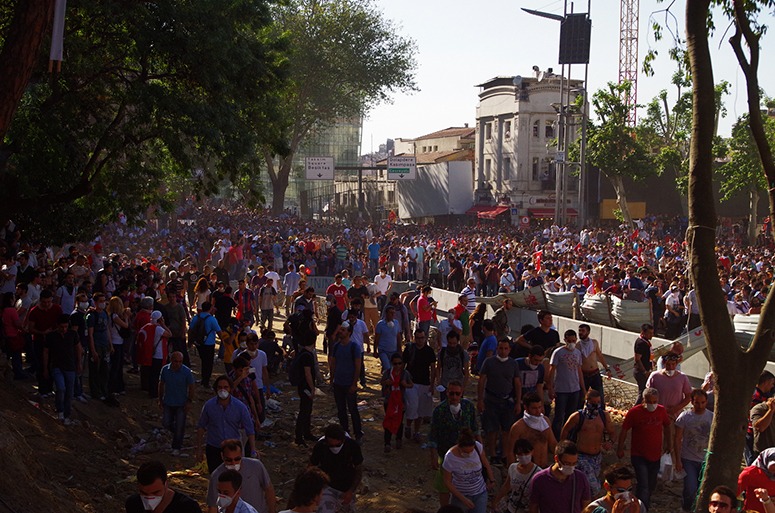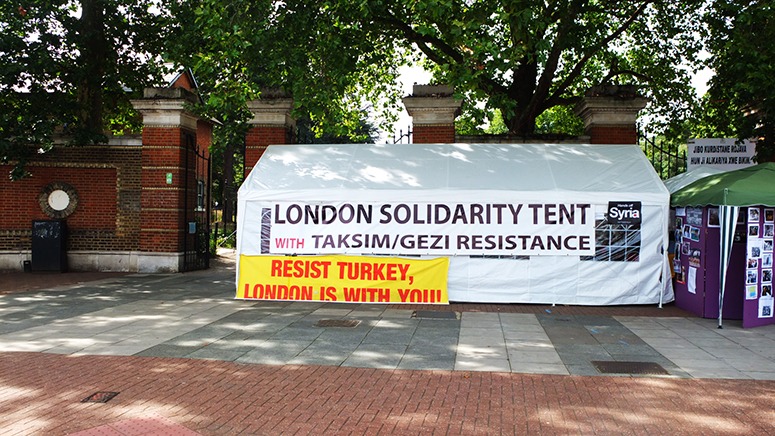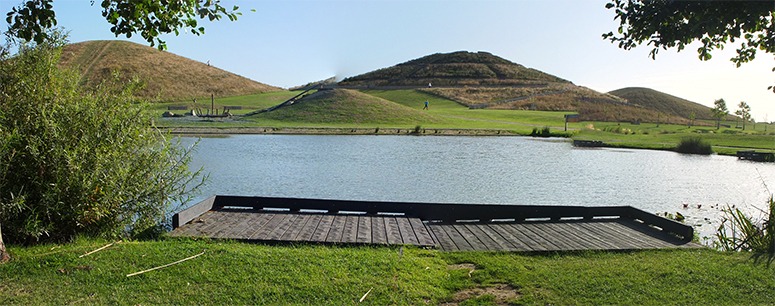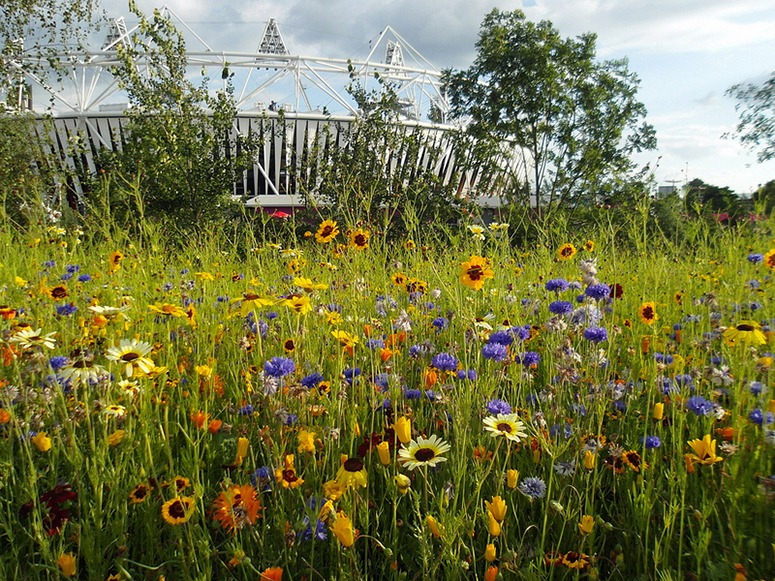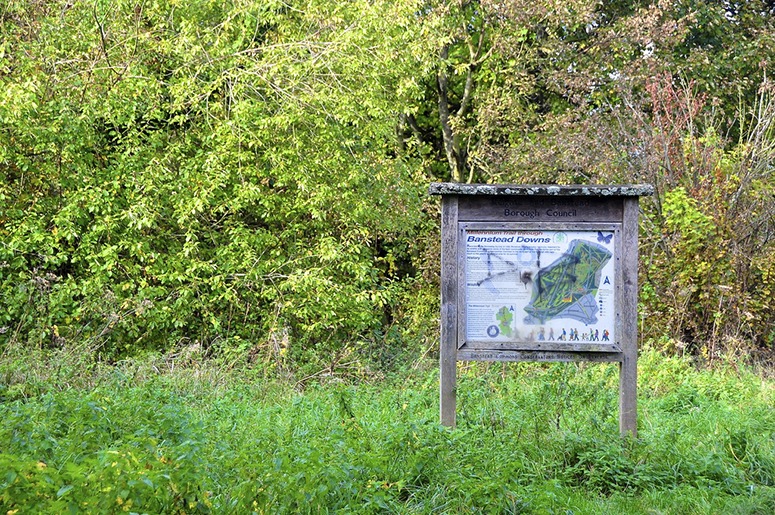
To make themselves richer, a few bloated putocrats seek to deprive the public of ‘public goods’. Sir John Craddock is a prime example:
A leaflet issued by Banstead Commons Conservators relates that in 1873 Sir John Cradock Hartopp Bt from Yorkshire bought 1700 acres of Banstead Commons. He planned to purchase the commoners’ rights and enclose and develop the most suitable parts. Turf, top soil, gravel, etc were to be removed and sold from Banstead Heath, and houses built. To stop this, local residents formed Banstead Commons Protection Committee in 1887. Legal action followed, culminating in Sir John’s bankruptcy. In 1893, Parliament passed the Metropolitan Commons (Banstead) Supplemental Act, protecting the downs from further development.’
I invite the landscape architects defending Taksim Gezi Meydani to celebrate Sir John’s downfall and bankruptcy. As Gloria Steinem said ‘Power can be taken, but not given. The process of the taking is empowerment in itself.
Image courtesy garda
Category Archives: Public parks
The landscape architecture of Taksim Gezi Meydani 'Park' or 'Square'
Queen Anne asked one of her Ministers what it would cost to stop public access to London’s Hyde park and was told, “It would cost you but three crowns, ma’am: those of England, Scotland and Ireland.” . Public open space should be at the centre of public debate.
The Bosphorus is the traditional boundary between Europe and Asia and also the meeting point of the two cultures which govern modern Turkey: western and eastern. Many Ottoman intellectuals and leaders came from western (European) Turkey. Though born in Istanbul, Recep Tayyip Erdoğan’s political culture has Anatolian roots. Ataturk, who founded the Turkish republic, was born in Greece and sought to westernise Turkey. So the question, as ever, is: will Turkey look east or will Turkey look west? We can extrapolate the choice to landscape architecture. Looking east, to the Turks’ nomadic past, suggests a lack of significance for permanent open space. Looking west, to the settled lands of Europe, suggests a desire to protect open space.
Though rendered in English as Taksim ‘Square’, the Turkish name is Taksim Meydanı. ‘Meydani’ derives from the Persian word maidan which was used for a multi-purpose civic space. It was not a park (paradaeza in Persian) and it was not usually planted. The uses included markets, parades, festivals, games and camping. This made it a very important place – though the famous maidan in Isfahan has since been laid out as a western park and is not busy. So should Turkish landscape architects look west or east? Both. Topkapi Palace is a good symbol for this: the pattern of its open spaces is that of an encampment, but the encampment has become permanent (as Gülru Necipoğlu, explains in Architecture, ceremonial, and power: The Topkapı Palace in the fifteenth and sixteenth centuries. Cambridge, Mass, 1991).
Well, Istanbul lost its chance to host the 2020 Olympics yesterday for, it is thought, two reasons (1) the brutal treatment of protesters over the proposed development of Taksim Gezi (2) Turkey’s poor record in controlling the use of drugs by its athletes. I give my sympathy to the landscape architects and others involved in Istanbul’s bid and have no hesitation in saying that the landscape architecture of Istanbul is of the very highest quality.
I am pleased to report that London’s park users (photo of the gates of Finsbury Park below) support Istanbul’s park users in calling for the conservation of Taksim Gezi Meydani. We might be able to send protesters if another occupation becomes necessary but we are not considering armed intervention of any kind.
Top image of Taksim Gezi courtesy Alan Hilditch. Lower image Gardenvisit.com
Northala Fields – the landscape planning of a public park
– the conical hills look good, shield the park from traffic noise, provide destinations for walkers and runners and offer fine views over London. They were made out of rubble from demolishing the old Wembley Stadium. That’s good too – but I wish they had salvaged some features instead of reducing everything to rubble.
– the water park to the south of the hills is an attractive place with ponds, trees, shrubs and wild life
The landscape design was by FoRM Associates, a London practice which was run by Igor Marko, Peter Fink and Rick Rowbotham (the firm operated from 2007-2012). The founders were an artist, an architect and a landscape architect but the latter is not credited with the project: it was regarded as public art.
My visit was a deviation from the route of London’s Capital Ring, which I have been following. It links a number of greenspaces of varying quality. I suppose I could set up a system to assess their quality and, if doing so, would remember the four lunches I have enjoyed in a four day trip. Each time I asked for a ‘bacon roll and cappucino’. Much the best was in a cafe near Eltham College – maybe the boys have trained them. The cost was £3.70. Next best was from a caravan in Richmond Park: £5.20 – good coffee and a very well cooked bacon roll for £5.20. Next best was from a cafe outside Harrow School: £7.20 for a decent coffee with a disappointing bacon sandwich. Worst quality was from a transport cafe beside Streatham Common: £2.70 for flabby white bread and tough bacon. ‘This is not coffee’ I complained after the first sip ‘Yeah – we don’t do coffee’ they told me. The compensation was free newspapers to read (Sun and Star only). Price is the easiest thing to assess but does not correlate with gastronomic quality (for which my assessment criteria were: quality of coffee, quality of bread and quality of bacon. Price does however correlate exactly with quality of service. The most expensive provider also had the best interior design, though it was very traditional. The seating area around the caravan in Richmond Park was a total disgrace ‘wood effect picnic seating made of solid plastic’. So is it true that ‘you get what you pay for’? No: if you want a coffee and bacon sandwich the best buy cost £3.70. The same is true of public open space: the largest budget does NOT produce the best design. Much better to deploy imagination, ingenuity and wisdom.
Ultra-safe policing in London public parks
Britain’s police forces have been criticised for heavy-handed policing. From time to time, policing shows every sign of being based on prejudice and self interest tempered with sloth and incompetence. We have had the Birmingham Six, the Guildford Four, the Maguire Seven, Jean de Menezes, Ian Tomlinson, Bloody Sunday and this week’s Hillsborough Report. They are deeply troubling and when the ‘Independent’ Police Complaints Commission investigates it is like the KGB investigating the Stasi. But NO ONE can accuse the police of neglecting the excruciatingly arduous task of policing the Royal Parks, THANK GOD.
Wildflower meadows in London's 2012 Queen Elizabeth Olympic Park
The BBC Today Programme (7.45 on 20.8.2012) had an item about the wildflower meadows being one of the great successes of the 2012 Olympic Games. I congratulate Nigel Dunnett and James Hitchmough on their planting design – and would like to know more about the origins of the planting design idea. Their history may be as follows, but any extra details from readers would be welcome:
- EDAW (now AECOM) produced the master plan for what was the Olympic Park during the games and will re-open as the Queen Elizabeth Park in 2013. The idea for the planting design may have been theirs.
- LDA with George Hargreaves produced the design plans – and probably commissioned Dunnett and Hitchmough.
- LDA were guided by the Olympic Development Authority ODA and by John Hopkins, landscape architect and Head of Parklands & Public Realm at the Olympic Development Agency
- Dunnett and Hitchmough were probably inspired by Piet Oudolf’s ideas on New Perennial planting design
- Oudolf probably drew on Christopher Lloyd’s advocacy of wildflower meadows, and his work at Great Dixter
- Christopher Lloyd was inspired by his mother, the beautifully named Daisy Lloyd, who made a flowery meadow at Dixter which she connected with the meadows in renaissance painting (eg Botticelli’s Primavera) and Pre-Raphaelite painting. Daisy also introduced Christopher to Gertrude Jekyll – and both were surely influenced by William Robinson.
- Gertrude Jekyll popularised the idea of using plants in ‘drifts’
- William Robinson shared John Ruskin’s love of the middle ages. He wrote a famous book on The Wild Garden and advocated ‘wild flower meadows’ instead of mown grass.
- A medieval ‘meadow’ was ‘a piece of land permanently covered with grass to be mown for use as hay’ OED (mædewan, mædua, mæduen, etc in Old English).
- Meadows contained wild flowers and meadow turf was cut from pastures and laid in gardens, probably as ground cover in small herbers for the delight of ladies and minstrels. ‘Mead’ is cognate with meadow. Deriving from Old Dutch and Old German, it was used rarely in Old English but later became popular with poets etc in the combination ‘flowery mead’.
The flowers in old English meadows were, of course ‘wild’ flowers. Those used in the Olympic 2012 Queen Elizabeth Park were wild somewhere at some time. But many are cultivars from outside the UK. If my plant identification is satisfactory, the above photograph has: Coreopsis (Tickseed, native to North America), Centaurea cyanus (Cornflower, native in the UK), Chrysanthemum carinatum ‘Polar Star’ (a cultivar of the annual chrysanthemum, native to North America), Calendula spp (pot marigold, native to the Middle East). The drifts of annual and perennial plants in the Lea Valley have visual connections with meadows and the flowers are, or were, wild in some place at some time. But they will not be used as pastures and one could make a good case for NOT calling them ‘wildflower meadows’. As Immanual Kant observed, paradox is an inescapable aspect of how we understand the world.
Space and place
Famous Danish Urbanist Jan Gehl after a nine month study of central Sydney in 2007 called for the addition of three new public squares along George Street:
“His report paints a picture of a city at war with itself – car against pedestrian, high-rise against public space. “The inevitable result is public space with an absence of public life,” he concludes.
His nine-month investigation found a city in distress. A walk down Market Street involved as much waiting at traffic lights as it did walking. In winter, 39 per cent of people in the city spend their lunchtimes underground, put off by a hostile environment at street level: noise, traffic, wind, a lack of sunlight and too few options for eating.”
If the City of Sydney was to implement his vision how would the addition of public space improve the perception of place in Sydney?
The City of Miami is also feeling the lack of a public centre. In considering the attributes of good public squares they describe a few of the most successful spaces in the US, including Union Square and Madison Square.
Feel free to nominate your favourite public square and tell us why it is so good!

